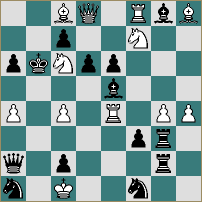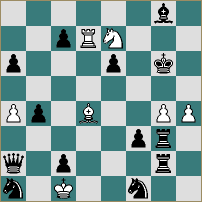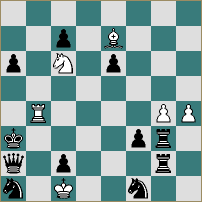Patrick of Hull
The following mysterious caption appeared alongside the given diagram in the Christmas Eve edition of the Hull & Lincolnshire Times, 1915.
‘‘Composed specially for the ‘Hull Times’ by a well known local amateur. The author is not quite sure whether the composition is a stroke of genius or merely an instance of misplaced ingenuity and to be on the safe side prefers to hide his identity under the pseudonym attached. Perhaps our readers will settle his doubts for him.’’
Modern day composers are not usually so publicity shy. I’ve spoken to several of my colleagues in the problem world and none of them have ever heard of Patrick of Hull. The magnificent chess display you are about to witness is, it seems, almost completely unknown. Another mystery concerns the stipulation ‘mate in 32’ since it is, in fact, mate in 31! The solution is also White's only way of winning the position.
It is an extremely difficult problem to solve. Feel free to try it if you want to but be warned - it could be a career decision! I recommend simply playing over the beautiful solution and enjoying the many fine points and spectacular mates involved.
Patrick of Hull
Hull Times, 1915
 Despite the board full of pieces, the strategy involved is very clear. With Black threatening some nasty mates, White cannot lose any time. Check seems obligatory; so forget about refined positional judgement and get into pure calculation mode. You may or may not like the first phase of the solution but, as you will see, a striking effect is achieved.
1 c5+!
There are three possible checks. 1 Qxc7+? Kxc7 leads nowhere very quickly, but the most natural move also fails: 1 a5+? Qxa5! 2 Nxa5 Ne3 and Black is winning.
1 ... dxc5
White is motoring after 1...Kxc5? 2 Rxe5+ dxe5 3 Qe7+.
2 Rb4+! cxb4
A pawn sacrifice has been followed up with the offer of a rook. What’s next?
3 Qd4+!! Bxd4
Despite the board full of pieces, the strategy involved is very clear. With Black threatening some nasty mates, White cannot lose any time. Check seems obligatory; so forget about refined positional judgement and get into pure calculation mode. You may or may not like the first phase of the solution but, as you will see, a striking effect is achieved.
1 c5+!
There are three possible checks. 1 Qxc7+? Kxc7 leads nowhere very quickly, but the most natural move also fails: 1 a5+? Qxa5! 2 Nxa5 Ne3 and Black is winning.
1 ... dxc5
White is motoring after 1...Kxc5? 2 Rxe5+ dxe5 3 Qe7+.
2 Rb4+! cxb4
A pawn sacrifice has been followed up with the offer of a rook. What’s next?
3 Qd4+!! Bxd4
4 Bxd4+ Kxc6
It seems White has already been more than generous, but there’s more to come. If 5 Ne5+ Kd5 6 Rd8+ Ke4 7 Bb7+ Black interposes with 7...Qd5.
5 Bb7+!! Kxb7
The end of the introduction. White has sacrificed, in order of disappearance, P, R, Q, N, and B - one of everything. I am not aware of such a theme having a name and suggest the title ‘complete hack’. In this case the sacrifices were uninterrupted, coming one after the other; should there be other moves between the sacrifices, one could call it a disjointed complete hack.
The second phase of the solution features the most extraordinary piece co-ordination I have ever seen. It is slightly more ‘solver friendly’ than the first phase - club players may find it instructive to try and calculate ahead for the next twenty odd moves. Failing that, just sit back and watch as the remaining white rook, bishop and knight weave their magic.
6 Nd8+ Kc8!
Not 6...Kb8? because of 7 Nc6+ Kb7 8 Na5#.
7 Nc6+ Kd7!
8 Nb8+
Equally effective is 8 Ne5+ which transposes back to the main line in two moves time. This one minor ‘dual’ is not very significant.
8 ... Kd6!
If 8...Ke7? 9 Bc5#.
9 Rd8+ Ke7
10 Nc6+ Kf7
11 Rd7+! Kg6!
Others are worse: 11...Ke8 12 Re7+ Kf8 13 Bg7#; 11...Kf8 12 Bg7+ Ke8 13 Re7#.
12 Ne7+!
 12 ... Kf7
After 12...Kh7 13 Nf5+ Bf7 14 Rxf7+ Kg8 15 Nh6#. Also inadequate is 12...Kh6 13 Nxg8+ Kg6 14 Rg7#.
13 Nd5+! Kg6
13...Ke8 leads to another mate: 14 Nf6+ Kf8 15 Bc5#.
14 Nf4+ Kh6
12 ... Kf7
After 12...Kh7 13 Nf5+ Bf7 14 Rxf7+ Kg8 15 Nh6#. Also inadequate is 12...Kh6 13 Nxg8+ Kg6 14 Rg7#.
13 Nd5+! Kg6
13...Ke8 leads to another mate: 14 Nf6+ Kf8 15 Bc5#.
14 Nf4+ Kh6
15 Bg7+ Kh7
16 Bf6+! Bf7!
16...Kh6? 17 Bg5# illustrates the precision of White's last move.
17 Rxf7+ Kg8
18 Rg7+ Kf8
19 Ng6+ Ke8
20 Rg8+!
Another good decision. It is so easy to go wrong: 20 Re7+? Kd8 and progress is hard to come by.
20 ... Kd7!
A short mate results from 20...Kf7? 21 Rf8+! Kxg6 22 h5+ Kh7 23 Rh8#.
21 Ne5+! Kd6
22 Rd8+ Kc5
23 Be7+ Kb6
24 Rb8+! Ka5
24...Ka7 25 Nc6# is yet another mate.
25 Nc6+ Kxa4
26 Rxb4+ Ka3
 The second phase is over and just the final stage remains - how to finish the job. In its own unassuming way, the next move is perhaps the biggest shocker of all: after the astonishing sequence above comes a sudden change of pace, a ‘quiet’ (non-checking) move. Black is left helpless, despite the possible checks to the white king.
27 Nd4!! Nb3+
The second phase is over and just the final stage remains - how to finish the job. In its own unassuming way, the next move is perhaps the biggest shocker of all: after the astonishing sequence above comes a sudden change of pace, a ‘quiet’ (non-checking) move. Black is left helpless, despite the possible checks to the white king.
27 Nd4!! Nb3+
28 Rxb3+ Ka4
29 Rb4+ Ka3
It is here that the 1915 solution subtly loses a move with 30 Rb6+ c5 31 Bxc5+ Ka4 32 Rxa6#. Normally one would assume that this was just an oversight, but I have my doubts about Patrick of Hull making such a mistake. Could the composer of this position really miss the next move? My guess is that he did it deliberately to see if anyone would notice!
30 Rc4+! c5
31 Bxc5# 1-0
Levitt and Friedgood’s book ‘Secrets of Spectacular Chess’ (published by Batsford) puts forward a theory of chess aesthetics based on four elements - paradox, depth, geometry and flow. It is not my intention to explain these ideas fully in this article (you’ll have to see the book!) but I would like to discuss the above problem in terms of the new theory. What makes it such a rich solution? All four of the elements are present in large portions:
There is paradox in sacrifice. How is it that White's only way to win consists of giving away most of the army in the first five moves? The quiet move 27 Nd4!! is also strongly paradoxical - it goes against common sense that such a move can work.
The flow of the solution is probably its strongest point. The sequence from move six to move twenty-six (the second phase) shows how exciting ‘flow’ can be.
There are a number of deep moves in the solution; the point of these moves only becoming clear at a later stage. 5 Bb7+!! would be one example - you have to see 7...Qd5! to reject the more natural 5 Ne5+.
Geometry is a more complex notion. There are various effects throughout the 31 move sequence, but let me draw your attention to two. The five white sacrifices create an abstract pattern by virtue of being a complete set of sacrifices. This falls under what we call ‘extended geometry’. Another, more concrete effect is created by the march of the black king - in particular the way it goes from the queenside across the board to the h-file, only to be forced back to the a-file, where it is mated. This side to side effect would come under what we call ‘graphic geometry’.
Finally, I’d like to thank Eric Fisher for bringing this position to light in his excellent Hull Chess Club Magazine. It may be a bit late but, if you’re out there Patrick of Hull, rest assured - your composition is without doubt a stroke of genius.
Back
Top of this page
Main page


